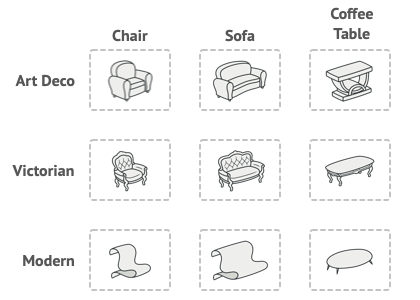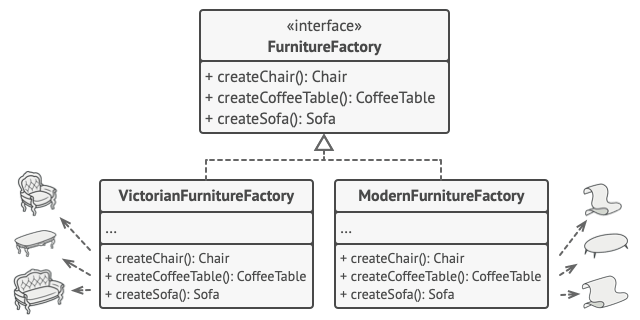什麼是抽象工廠
提供了一個用來創建一組相關或相互依賴對象的接口,而不需要指定具體的類。與工廠方法模式相比,抽象工廠模式不僅創建單一對象,還創建一組產品族(即多個相關的產品)。
主要特點:
- 產品族:抽象工廠模式是用來創建一組相關產品的工廠。每個具體工廠負責創建一組具體的產品。
- 解耦:抽象工廠模式能夠讓客戶端在不依賴具體類的情況下創建一組對象。
適用場景:當系統中有多個產品族,而客戶端需要根據具體情況創建不同的產品族時。
工廠 vs 抽象工廠
| 特徵 |
工廠模式 (Factory Method) |
抽象工廠模式 (Abstract Factory) |
| 目標 |
創建單一產品 |
創建一組相關的產品 |
| 重點 |
關注如何創建一個產品 |
關注如何創建一組互相關聯的產品 |
| 產品數量 |
只創建一個產品類型 |
同時創建多個相關的產品類型 |
| 擴展性 |
易於擴展單一產品的類型 |
易於擴展產品族,添加新的產品族 |
| 複雜性 |
相對簡單,適用於需要創建單一產品的情況 |
較複雜,適用於需要創建多個相關產品並且這些產品屬於同一族群的情況 |
| 客戶端 |
客戶端使用具體工廠來創建單一產品 |
客戶端使用抽象工廠來創建一組相關的產品 |
| 適用場景 |
當創建一個對象的過程需要封裝,且該對象是可擴展的 |
當系統中有多個產品族,且客戶端需要根據情況選擇創建一個產品族時 |
| 示例 |
創建不同類型的單一產品(如不同的交通工具:車、船、飛機) |
創建一組相關產品(如不同系列的家具:桌子、椅子、沙發) |
範例
家具有不同的功能,也有不同的風格

重構前
多層次equal 判斷
1
2
3
4
5
6
7
8
9
10
11
12
13
14
15
16
17
18
19
20
21
22
23
24
25
26
27
28
29
30
31
32
33
34
35
36
37
38
39
| public class FurnitureService {
public void createFurniture(String furnitureType, String style) {
if ("chair".equalsIgnoreCase(furnitureType)) {
if ("modern".equalsIgnoreCase(style)) {
System.out.println("創建現代風格椅子,功能:坐");
} else if ("classic".equalsIgnoreCase(style)) {
System.out.println("創建古典風格椅子,功能:坐");
} else if ("industrial".equalsIgnoreCase(style)) {
System.out.println("創建工業風格椅子,功能:坐");
} else {
throw new RuntimeException("未知的椅子風格:" + style);
}
} else if ("sofa".equalsIgnoreCase(furnitureType)) {
if ("modern".equalsIgnoreCase(style)) {
System.out.println("創建現代風格沙發,功能:坐");
} else if ("classic".equalsIgnoreCase(style)) {
System.out.println("創建古典風格沙發,功能:躺");
} else if ("industrial".equalsIgnoreCase(style)) {
System.out.println("創建工業風格沙發,功能:坐");
} else {
throw new RuntimeException("未知的沙發風格:" + style);
}
} else if ("coffeetable".equalsIgnoreCase(furnitureType)) {
if ("modern".equalsIgnoreCase(style)) {
System.out.println("創建現代風格咖啡桌,功能:放置咖啡");
} else if ("classic".equalsIgnoreCase(style)) {
System.out.println("創建古典風格咖啡桌,功能:放置咖啡");
} else if ("industrial".equalsIgnoreCase(style)) {
System.out.println("創建工業風格咖啡桌,功能:放置咖啡");
} else {
throw new RuntimeException("未知的咖啡桌風格:" + style);
}
} else {
throw new RuntimeException("未知的家具類型:" + furnitureType);
}
}
}
|
重構開始

圖為 https://refactoring.guru/ 的示意圖,以下code有做變更
定義包含返回訊息的enum
將功能放入enum,並定義家具的enum
1
2
3
4
5
6
7
8
9
10
11
12
13
14
15
16
17
18
19
20
21
22
23
24
25
26
27
28
29
30
31
32
33
34
35
36
37
38
39
40
41
42
43
44
45
46
47
48
49
50
51
52
53
54
55
| public enum FurnitureType {
CHAIR("椅子", Collections.singletonList(FunctionalityType.SIT)),
SOFA("沙發", Arrays.asList(FunctionalityType.SIT, FunctionalityType.LIE_DOWN)),
COFFEE_TABLE("咖啡桌", Collections.singletonList(FunctionalityType.PLACE_COFFEE));
private final String name;
private final List<FunctionalityType> functionalities;
FurnitureType(String name, List<FunctionalityType> functionalities) {
this.name = name;
this.functionalities = functionalities;
}
public String getName() {
return name;
}
public List<FunctionalityType> getFunctionalities() {
return functionalities;
}
}
public enum StyleType {
MODERN("現代"),
CLASSIC("古典"),
INDUSTRIAL("工業");
private final String name;
StyleType(String name) {
this.name = name;
}
public String getName() {
return name;
}
}
public enum FunctionalityType {
SIT("坐"),
LIE_DOWN("躺"),
PLACE_COFFEE("放置咖啡");
private final String action;
FunctionalityType(String action) {
this.action = action;
}
public String getAction() {
return action;
}
}
|
定義家具、風格和功能的接口
1
2
3
4
5
6
7
8
9
10
11
12
13
| public interface Furniture {
void describe();
}
public interface Style {
String getStyleName();
}
public interface Functionality {
String getFunctionality();
}
|
實現適配器,將家具、風格和功能組合:
由於功能與家具以做配對,使用適配器模式將風格和家具組合
1
2
3
4
5
6
7
8
9
10
11
12
13
14
15
16
17
18
| public class FurnitureAdapter implements Furniture {
private Style style;
private FurnitureType furnitureType;
public FurnitureAdapter(FurnitureType furnitureType, Style style) {
this.furnitureType = furnitureType;
this.style = style;
}
@Override
public void describe() {
System.out.print("創建" + style.getStyleName() + "風格的" + furnitureType.getName() + ",功能:");
List<FunctionalityType> functionalities = furnitureType.getFunctionalities();
System.out.println(functionalities.stream()
.map(FunctionalityType::getAction)
.collect(Collectors.joining("、")));
}
}
|
實現風格
1
2
3
4
5
6
7
8
9
10
11
12
13
14
15
16
17
18
19
20
21
22
| public class ModernStyle implements Style {
@Override
public String getStyleName() {
return StyleType.MODERN.getName();
}
}
public class ClassicStyle implements Style {
@Override
public String getStyleName() {
return StyleType.CLASSIC.getName();
}
}
public class IndustrialStyle implements Style {
@Override
public String getStyleName() {
return StyleType.INDUSTRIAL.getName();
}
}
|
實現功能
1
2
3
4
5
6
7
8
9
10
11
12
13
14
15
16
17
18
19
20
21
22
| public class SitFunctionality implements Functionality {
@Override
public String getFunctionality() {
return FunctionalityType.SIT.getAction();
}
}
public class LieDownFunctionality implements Functionality {
@Override
public String getFunctionality() {
return FunctionalityType.LIE_DOWN.getAction();
}
}
public class PlaceCoffeeFunctionality implements Functionality {
@Override
public String getFunctionality() {
return FunctionalityType.PLACE_COFFEE.getAction();
}
}
|
定義抽象工廠
1
2
3
4
5
6
7
8
9
10
11
| public abstract class AbstractFurnitureFactory {
protected abstract Style createStyle();
public Furniture createFurniture(FurnitureType furnitureType) {
Style style = createStyle();
return new FurnitureAdapter(furnitureType, style);
}
}
|
實現具體的工廠
1
2
3
4
5
6
7
8
9
10
11
12
13
14
15
16
17
18
19
20
21
22
23
24
25
|
public class ModernFurnitureFactory extends AbstractFurnitureFactory {
@Override
protected Style createStyle() {
return new ModernStyle();
}
}
public class ClassicFurnitureFactory extends AbstractFurnitureFactory {
@Override
protected Style createStyle() {
return new ClassicStyle();
}
}
public class IndustrialFurnitureFactory extends AbstractFurnitureFactory {
@Override
protected Style createStyle() {
return new IndustrialStyle();
}
}
|
test:
1
2
3
4
5
6
7
8
9
10
11
12
13
14
15
16
17
18
19
20
| public class ApiTest {
@Test
public void testFurnitureAdapter() {
Style style = new ModernStyle();
FurnitureType furnitureType = FurnitureType.CHAIR;
Furniture furniture = new FurnitureAdapter(furnitureType, style);
furniture.describe();
style = new ClassicStyle();
furnitureType = FurnitureType.SOFA;
furniture = new FurnitureAdapter(furnitureType, style);
furniture.describe();
style = new IndustrialStyle();
furnitureType = FurnitureType.COFFEE_TABLE;
furniture = new FurnitureAdapter(furnitureType, style);
furniture.describe();
}
}
|
1
2
3
| 創建現代風格的椅子,功能:坐
創建古典風格的沙發,功能:躺
創建工業風格的咖啡桌,功能:放置咖啡
|
圖源/參考資料:
https://refactoring.guru/
重學java設計模式-小博哥

